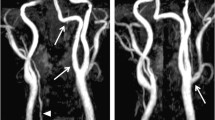Summary
Severe hemiatrophy of the right half of the tongue in a 22 year old patient was demonstrated to be due to compression of the hypoglossal nerve by a tortuous internal carotid artery in the neck. The nerve was trapped between an abnormal loop of the internal carotid artery and the sternoclcidomastoid branch of the occipital artery. Although impairment of cranial nerve function with cases of tortuous and dilated vessels has been reported frequently, twelfth nerve palsy has never been demonstrated before.
Similar content being viewed by others
References
Boeri, R., Passerini, A.: The megadolichobasilar anomaly. J. Neurol. Sci. 1, 475–484 (1964)
Brihaje, J., Perier O., Smulders, J., et al.: Glossopharyngeal neuralgia caused by compression of the nerve by an atheromatous vertebral artery. J. Neurosurg. 13, 294–302 (1956)
Campbell, R. I., Dyken, M. I.: Four cases of carotid-basilar anastomosis associated with central nervous system dysfunction. J. Neurol. Neurosurg. Psychiat. 24, 250–253 (1961)
Eckma, P. B., Kramer, R. A., Altrocchi, P. H.: Hemifacial spasm. Arch. Neurol. 25, 81–87 (1971)
Gardner, W. J., Sava, G. A.: Hemifacial spasm — A reversible pathophysiologic state. J. Neurosurg. 19, 240–247 (1962)
Hopkins, E. W., Poser, C. M.: Posterior cerebral artery ectasia. An unusual cause of ophthalmoplegia. Arch. Neurol. 29, 279–281 (1973)
Imparato A. M., Bracco, A., Kim, G. E.: The hypoglossal nerve in carotid arterial reconstructions. Stroke 3, 576–578 (1972)
Jannetta, P. J.: Arterial compression of the trigeminal nerve at the pons in patients with trigeminal neuralgia. J. Neurosurg. 26, 159–162 (1967)
Kempe, L. G., Smith, D. R.: Trigeminal neuralgia, facial spasm, intermedius and glossopharyngeal neuralgia with persistent carotid basilar anastomosis. J. Neurosurg. 31, 445–451 (1969)
Kerber, C. W., Margolis, M. T., Newton, T. H.: Tortuous vertebrobasilar system: a cause of cranial nerve signs. Neuroradiology 4, 74–77 (1972)
Mauersberger, W.: Cerebrale Durchblutungsstörungen und Parese des Nervus Hypoglossus bei extremer Schlingenbildung der Arteria Carotis Interna. Neurochirurgia 17, 91–95 (1974)
Mitts, M. G., McQueen, J.: Visual loss associated with fusiform enlargement of the intracranial portion of the internal carotid artery. J. Neurosurg. 23, 33–37 (1965)
Sacks, J. G., Lindenburg, R.: Dolicho-ectatic intracranial arteries: symptomatology and pathogenesis of arterial elongation and distention. Johns Hopkins Med. J. 125, 95–106 (1969)
Scotti, G.: Internal carotid origin of a tortuous posterior cerebral artery. A cause of ophthalmoplegia. Arch. Neurol. 31, 273–275 (1974)
Author information
Authors and Affiliations
Rights and permissions
About this article
Cite this article
Scotti, G., Melançon, D. & Olivier, A. Hypoglossal paralysis due to compression by a tortuous internal carotid artery in the neck. Neuroradiology 14, 263–265 (1978). https://doi.org/10.1007/BF00418626
Received:
Issue Date:
DOI: https://doi.org/10.1007/BF00418626




